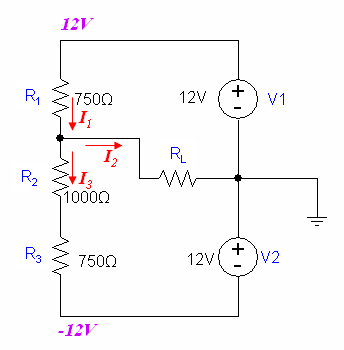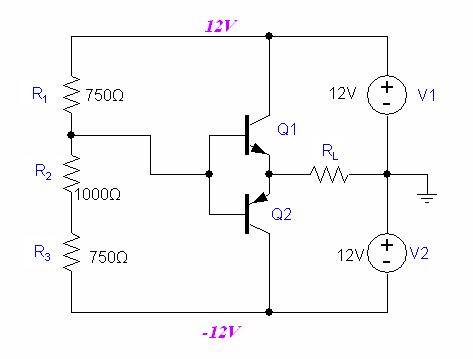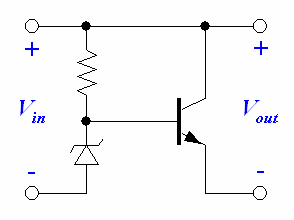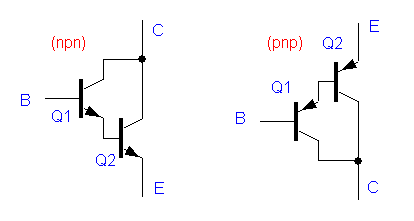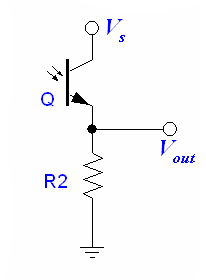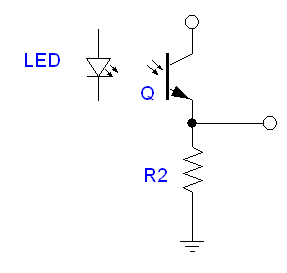Test
Push-Pull Follower Example: A (Poor) Motor Speed Controller
Suppose we want to control the speed of a motor by varying the input voltage between +5V and -5V. We attempt to do this by setting put a voltage divider with a potentiometer like in the circuit below.
We model our motor with a simple resistor . If is infinitely large (no current flowing through), then there will be a 7.2V drop across and , and can take a value between 4.8V and -4.8V.
For the maximum voltage case (we turn the POT all the way to one side), our circuit with voltage sources looks like this:
We know that is not infinitely large because motors can draw quite a lot of current. If (short circuit), then the . We can expect to be somewhere between 0V and 4.8V.
We can solve the circuit with the following equations:
KCL:
KVL:
Solving the equations yields:
If Ω, we can plug it in and find that is only equal to 0.0897V and the current is equal to 8.97mA—not nearly enough to drive the motor.
It turns out that the voltage controlling circuit cannot supply much current, so the low impedance of the motor drains what current is available very quickly and pulls down the output voltage. When the impedance of the power source is much larger than the impedance of the load, this is known as loading.
We can't use this circuit to drive a motor directly, because our controller needs to see a high impedance, but our motor has a low impedance—we need a way to isolate the controller from the motor. This is where we can use our push-pull current amplifier. We connect it to our circuit as shown below to better isolate the controller from the motor and amplify the current. Unfortunately, the transistors only have a gain of about 100, so the controller circuit still does not see an infinite impedance.
Emitter Follower Voltage Regulator
With our previous voltage regulator with the zener diode, we had the problems of the zener diode wasting power and needing a high power diode if there was a lot of current going through the diode. If we add an emitter-follower, we can use a much smaller diode and less current to achieve the same effect.
Darlington Pair
If we need a very high current gain, we replace a transistor with a Darlington pair. The current gain is now:
Field Effect Transistors (FET)
FETs are a type of transistor that uses a voltage input to control its conductivity (as opposed to using the current like a BJT). The input impedance is very high and thus draws very little current. There are three general types of FETs:
1.enhancement mode metal-oxide-semiconductor FETs (MOSFETs)
2.depletion mode MOSFETs
3.Junction FETs (JFETs)
MOSFETs
The symbol for a MOSFET looks like this: 
where G is for gate, S for source, D for drain, and B for substrate.
However, since B is usually connected to S, the symbol is often simply drawn as: 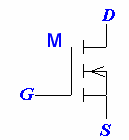
Electrons flow from the source to the drain, so the current flows from drain to source. The gate receives the input voltage. The gate pin is offset towards to source pin to help is differentiate between the source and drain pins.
MOSFETS come in enhancement and depletion modes. An enhancement mode MOSFET allows a current to flow only if a positive voltage is applied, while depletion mode MOSFETs allows a current to flow even if no voltage difference is applied. Increasing the voltage increases the current, and it takes a negative voltage to turn off a depletion mode MOSFET. MOSFETS, like BJTs, also come in p and n types. The different MOSFETS and their corresponding symbols are below:
| n-channel | p-channel | |
|---|---|---|
| Enhancement | 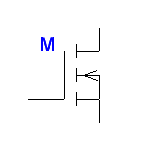 |
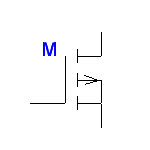
|
| Depletion |  |
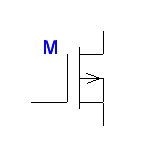
|
JFETs
JFETs are very similar to MOSFETS, but they only come in the depletion-mode variety. JFET consume little power, so they are often found in low-power applications. The symbols for JFETs are below:
| n-channel | p-channel | |
|---|---|---|
| Depletion | 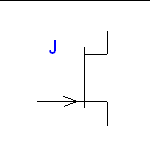 |
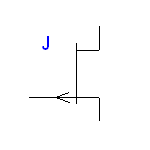
|
Phototransistor
Notice that the phototransistor only has two legs.
The collector current of a phototransistor is proportional to the light or infrared light received.
can take a value between 0V and .
Go to the phototransistor page for more information on phototransistors.
Emitter/Detector pair:
An emitter-detector pair is a very useful circuit that can be used to isolate two circuits or used as a sensor. Among other applications, it can be used to detect changes in the distance between the emitter and detector (changing the distance changes the intensity of the received light) or used to detect interruptions in the light beam.
A photodiode can also be used instead of a phototransistor in many applications; a photodiode cannot supply as much current, but has a faster response time.
References
Alciatore, David G. and Michael B. Histand. Introduction to Mechatronics and Measurement Systems. 2nd ed. New York, NY:McGraw-Hill, 2003.





